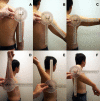In-vivo glenohumeral translation and ligament elongation during abduction and abduction with internal and external rotation
- PMID: 22741601
- PMCID: PMC3403937
- DOI: 10.1186/1749-799X-7-29
In-vivo glenohumeral translation and ligament elongation during abduction and abduction with internal and external rotation
Abstract
Study design: Basic Science. To investigate humeral head translations and glenohumeral ligament elongation with a dual fluoroscopic imaging system.
Background: The glenohumeral ligaments are partially responsible for restraining the humeral head during the extremes of shoulder motion. However, in-vivo glenohumeral ligaments elongation patterns have yet to be determined. Therefore, the objectives of this study were to 1) quantify the in-vivo humeral head translations and glenohumeral ligament elongations during functional shoulder positions, 2) compare the inferred glenohumeral ligament functions with previous literature and 3) create a baseline data of healthy adult shoulder glenohumeral ligament lengths as controls for future studies.
Methods: Five healthy adult shoulders were studied with a validated dual fluoroscopic imaging system (DFIS) and MR imaging technique. Humeral head translations and the superior, middle and inferior glenohumeral ligaments (SGHL, MGHL, IGHL) elongations were determined.
Results: The humeral head center on average translated in a range of 6.0mm in the anterior-posterior direction and 2.5mm in the superior-inferior direction. The MGHL showed greater elongation over a broader range of shoulder motion than the SGHL. The anterior-band (AB)-IGHL showed maximum elongation at 90° abduction with maximum external rotation. The posterior-band (PB)-IGHL showed maximum elongation at 90° abduction with maximum internal rotation.
Discussion: The results demonstrated that the humeral head translated statistically more in the anterior-posterior direction than the superior-inferior direction (p = 0.01), which supports the concept that glenohumeral kinematics are not ball-in-socket mechanics. The AB-IGHL elongation pattern makes it an important static structure to restrain anterior subluxation of the humeral head during the externally rotated cocking phase of throwing motion. These data suggest that in healthy adult shoulders the ligamentous structures of the glenohumeral joint are not fully elongated in many shoulder positions, but function as restraints at the extremes of glenohumeral motion. Clinically, these results may be helpful in restoring ligament anatomy during the treatment of anterior instability of the shoulder.
Figures








Similar articles
-
Effect of glenohumeral ligaments on posterior shoulder stabilization: a biomechanical study.Am J Transl Res. 2023 Mar 15;15(3):1953-1963. eCollection 2023. Am J Transl Res. 2023. PMID: 37056804 Free PMC article.
-
The effect of articular malposition after total shoulder arthroplasty on glenohumeral translations, range of motion, and subacromial impingement.J Shoulder Elbow Surg. 2001 Sep-Oct;10(5):399-409. doi: 10.1067/mse.2001.116871. J Shoulder Elbow Surg. 2001. PMID: 11641695
-
Glenohumeral translation during active external rotation with the shoulder abducted in cases with glenohumeral instability: a 4-dimensional computed tomography analysis.J Shoulder Elbow Surg. 2019 Oct;28(10):1903-1910. doi: 10.1016/j.jse.2019.03.008. Epub 2019 Jun 14. J Shoulder Elbow Surg. 2019. PMID: 31204064
-
Inferior glenohumeral ligament (IGHL) complex: anatomy, injuries, imaging features, and treatment options.Emerg Radiol. 2017 Feb;24(1):65-71. doi: 10.1007/s10140-016-1431-0. Epub 2016 Aug 16. Emerg Radiol. 2017. PMID: 27530740 Review.
-
Glenohumeral stability. Biomechanical properties of passive and active stabilizers.Clin Orthop Relat Res. 1996 Sep;(330):13-30. Clin Orthop Relat Res. 1996. PMID: 8804270 Review.
Cited by
-
Techniques for In Vivo Measurement of Ligament and Tendon Strain: A Review.Ann Biomed Eng. 2021 Jan;49(1):7-28. doi: 10.1007/s10439-020-02635-5. Epub 2020 Oct 6. Ann Biomed Eng. 2021. PMID: 33025317 Free PMC article. Review.
-
Fractures of the coracoid process: a systematic review.JSES Rev Rep Tech. 2021 May 12;1(3):171-178. doi: 10.1016/j.xrrt.2021.04.008. eCollection 2021 Aug. JSES Rev Rep Tech. 2021. PMID: 37588963 Free PMC article. Review.
-
Effect of different loads on the shoulder in abduction postures: a finite element analysis.Sci Rep. 2023 Jun 11;13(1):9490. doi: 10.1038/s41598-023-36049-9. Sci Rep. 2023. PMID: 37303006 Free PMC article.
-
Accuracy and Reliability of Synthetic Computed Tomography for Model-Based Tracking of Biplane Videoradiography Data.Ann Biomed Eng. 2025 Aug 23. doi: 10.1007/s10439-025-03831-x. Online ahead of print. Ann Biomed Eng. 2025. PMID: 40849362
-
Exercise therapy for treatment of supraspinatus tears does not alter glenohumeral kinematics during internal/external rotation with the arm at the side.Knee Surg Sports Traumatol Arthrosc. 2018 Jan;26(1):267-274. doi: 10.1007/s00167-017-4695-3. Epub 2017 Sep 1. Knee Surg Sports Traumatol Arthrosc. 2018. PMID: 28865049 Clinical Trial.
References
-
- Burkart AC, Debski RE. Anatomy and function of the glenohumeral ligaments in anterior shoulder instability. Clin Orthop Relat Res. 2002;400:32–39. - PubMed
-
- Turkel SJ, Panio MW, Marshall JL, Girgis FG. Stabilizing mechanisms preventing anterior dislocation of the glenohumeral joint. J Bone Joint Surg Am. 1981;63:1208–1217. - PubMed
Publication types
MeSH terms
LinkOut - more resources
Full Text Sources

